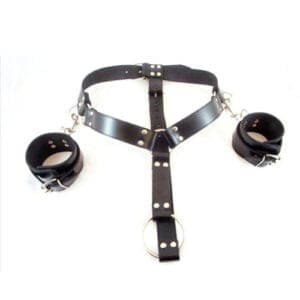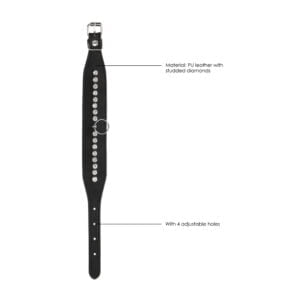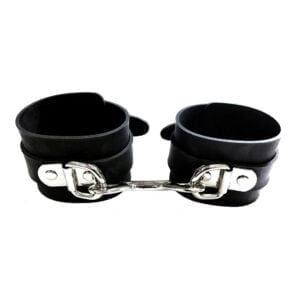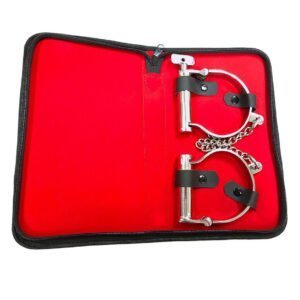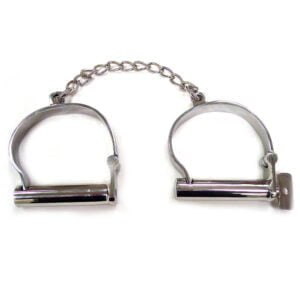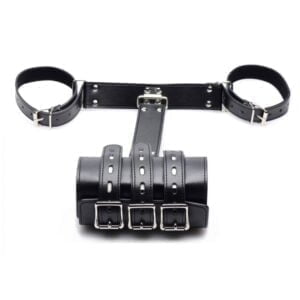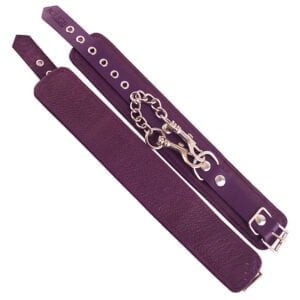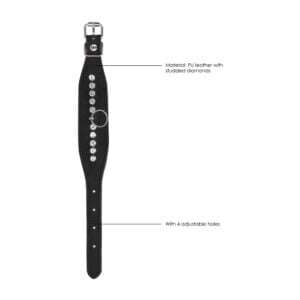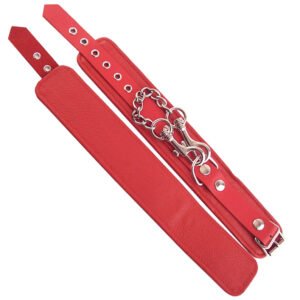Sign in
Login
Register
0
£ 0.00
0
Shopping cart (0)
Subtotal: £ 0.00
Spend £ 149.00 to get free shipping!
Congratulations! You've got free shipping.
FREE worldwide shipping on orders £149+
FREE UK shipping on orders £49+ and FREE worldwide shipping on orders £149+
Go Shopping
Sign in
Login
Register
FREE UK shipping on orders £49+ and FREE worldwide shipping on orders £149+
Go Shopping
Rouge Garments Cuff Harness
SKU: RCH1002 £ 80.99Select options This product has multiple variants. The options may be chosen on the product page Add to CompareKink Bind And Tie Initiation 5 Piece Hemp Rope Kit
SKU: 2404-15-BX £ 124.99Add to basket Add to CompareRestraints in BDSM are tools that enhance trust and intimacy between participants. They can range from simple wrist or ankle cuffs to advanced equipment like the unique magnetic self-bondage lock available from specialised retailers. This variety allows us to explore different levels of intensity and play styles.It's important for any participant to feel safe and secure, both physically and emotionally. Knowing each other's boundaries and desires and agreeing on safe words ensures that BDSM play remains consensual and enjoyable for everyone involved. Whether you're new to this scene or have years of experience, access to diverse and well-crafted gear, like that found on platforms such as Capper Street Dungeon, can add a thrilling dimension to our experiences.
Understanding BDSM and Restraint Practices
In this section, we explore the key aspects of BDSM, focusing specifically on the role of restraints. We delve into the dynamics between roles, highlight the importance of consent and safety, and discuss the psychological aspects that contribute to the appeal of restraint play.The Basics of BDSM
BDSM stands for Bondage and Discipline, Dominance and Submission, Sadism and Masochism. It encompasses a range of practices that involve power play and role exploration. Restraints are commonly used in BDSM to restrict movement, creating a sense of surrender or vulnerability. These can include ropes, handcuffs, or even mental constraints through verbal commands. The aim is to provide a controlled environment where participants can explore their fantasies safely.Restraints might also include sensory deprivation tools, such as blindfolds, which enhance the experience by heightening other senses. Each activity is often tailored to the preferences and boundaries of those involved, respecting personal limits and ensuring mutual satisfaction.Roles and Dynamics in Restraint Play
In restraint play, participants typically assume specific roles, such as the Dominant and the Submissive. The Dominant takes control, applying restraints and guiding the scene. The Submissive willingly surrenders control, finding pleasure and fulfilment in the act of submission. This dynamic allows participants to explore trust and power exchange in a consensual setting.Each play session might involve negotiated scenarios in which the desires and limits of all individuals are thoroughly discussed. The roles can be fluid, with participants occasionally switching responsibilities, embracing versatility and diversity in their interactions.Communication is key in these dynamics to prevent misunderstandings and ensure a favourable experience for everyone involved.Consent and Safety Considerations
Consent is the foundation of any BDSM activity. All parties must agree on what will occur and have the freedom to say no at any point. A common method is the use of a safe word, a pre-agreed signal to pause the scene if anything becomes uncomfortable or unsafe.Ensuring physical and emotional safety is vital. This involves discussing boundaries in advance and understanding each other's needs and limits. Participants may also establish aftercare routines to help transition out of the intense experience, providing support and reinforcing trust between partners.Psychology Behind Restraint
Restraint often plays a significant psychological role in BDSM, providing an altered state of consciousness or emotional catharsis. For some, the act of giving or taking control through restraint can lead to a release of endorphins, producing heightened pleasure or emotional relief.This form of kink allows individuals to safely explore deeper aspects of their personality, including needs for power or vulnerability. Engaging in restraint play can be a way to form a deeper connection with a partner, enhancing trust and communication while traversing each other's psychological landscapes.Types of Restraints and Accessories
Exploring BDSM restraints can be an exciting way to enhance trust and intimacy in relationships. The following sections provide a closer look at different types of restraints and accessories, each offering unique possibilities for those interested in bondage.Handcuffs and Wrist Restraints
Handcuffs and wrist restraints are essential components of many BDSM experiences. They come in various materials, including metal, leather, and soft fabric, each offering different levels of comfort and security. Handcuffs are popular for their classic look and feel, often seen in the BDSM context for their strong restriction.Wrist restraints, on the other hand, provide more comfort, especially those with padding or adjustable straps. They often include D-rings for easy attachment to other bondage gear, such as ropes or chains, allowing for versatile play.Ankle Cuffs and Leg Restraints
Ankle cuffs and leg restraints are designed to limit lower body movement. Like wrist restraints, ankle cuffs come in various materials, including leather and neoprene. Some models feature locking buckles for added security during play. These restraints can be part of a bondage kit or sold separately.Leg restraints can include more elaborate designs like spreader bars that hold the legs wide apart. This gear enhances vulnerability and can be used in combination with other restraints for added impact.Collars and Leashes
Collars and leashes are significant symbols within BDSM dynamics. Often made of leather or metal, collars can denote submission, ownership, or style within fetish fashion. They may come with rings or loops to attach leashes or other restraints, creating diverse possibilities for control.Leashes, usually paired with collars, allow the dominant partner to guide or lead, adding an aspect of control. Whether for aesthetic, symbolic, or practical reasons, collars and leashes remain popular in many BDSM scenarios.Rope and Bondage Rope Techniques
Rope is a versatile tool in the world of BDSM. It is often used for bondage rope techniques, which include intricate patterns and knots. Materials like jute or cotton are preferred due to their strength and texture. This allows the practitioner to create beautiful or functional bindings.Experienced users may engage in rope suspension, which requires specialised skills and safety knowledge to prevent injury. Bondage rope techniques can range from simple to highly artistic, offering endless possibilities for creativity and expression.Blindfolds, Hoods, and Gags
Sensory deprivation can enhance other senses, making blindfolds, hoods, and gags exciting accessories. Blindfolds and hoods restrict sight, heightening touch and sound. They are available in materials ranging from soft silk to firm leather, each providing different sensory experiences.Ball gags and similar mouth restraints limit speech, adding another layer of submission. It's vital to ensure communication remains possible by using safe gestures or sounds. These accessories play with control, trust, and vulnerability, key elements in BDSM exploration.Specialised Bondage Gear
Beyond basic restraints, specialised bondage gear offers advanced options for enthusiasts. This includes suspension bars, nipple clamps, and bondage tape, each providing unique sensations and challenges. Suspension bars enable vertical binding, adding a new dynamic to the experience.Nipple clamps can be used to introduce mild to intense sensations, enhancing arousal for some. Bondage tape doesn't stick to skin but adheres to itself, making it a flexible addition to any bondage kit. These diverse tools enrich the BDSM practice, allowing for tailored and personal experiences.Starting with Restraint in BDSM
Exploring restraint within BDSM can be both thrilling and rewarding. Understanding the basics, selecting suitable tools, learning advanced techniques, and combining restraints with other elements of kink can all enhance our experiences in bondage play.Beginners' Guide to Bondage and Restraint
For those new to BDSM, restraints can range from soft handcuffs to more intricate rope bondage. Safety is key, so we should always communicate boundaries and establish a safe word. Starting simply, perhaps with blindfold or light wrist restraints, allows us to explore comfort levels and sensations.We should also consider the emotional aspects, as bondage often involves building trust. Knowing our partner feels secure can lead to shared enjoyment.Choosing the Right Equipment
There are numerous types of restraints available, and choosing the right ones depends on our preferences and experience levels. Soft cuffs, rope, and blindfolds are good starting points for beginners. As we become more comfortable, equipment like spreader bars and restraint toys can be introduced.It's important to invest in quality gear that is safe and easy to use. Proper fit and material can make a significant difference in ensuring comfort and security during sessions.Progressing in Restraint Techniques
As our experience with BDSM grows, we can explore more complex techniques. Advanced bondage might include rope tying, which requires precise skill. Spreader bars can add a new dimension, opening up the body for exploration and play.It's vital to invest time in learning safe practices. Workshops and online tutorials provide step-by-step guidance. Communicating openly with our partner can help tailor these experiences, ensuring they are both safe and enjoyable.Combining Restraints with Other Kinks
Incorporating restraints into other kinks can enhance the sensations and overall experience. Pairing restraints with sensory toys, like feathers or floggers, can elevate arousal and excitement. Combining elements of power exchange, where one partner takes control within agreed limits, deepens the shared experience.Imagination plays a key role. We might use themes or scenarios to bring creativity into our sessions. Clear communication about boundaries and desires is essential to ensure mutual satisfaction. Exploring these combinations responsibly can lead to more fulfilling and nuanced interactions in our BDSM journey.Maintaining Safety and Aftercare
In BDSM, maintaining safety and effective aftercare is crucial. We need to ensure that everyone feels secure and respected. Establishing clear communication through safe words and providing thorough aftercare for physical and emotional well-being are essential practices.The Importance of Safe Words
Safe words play a crucial role in BDSM practices. They allow participants to communicate their limits clearly. During scenes, we might explore power dynamics and intense sensations, requiring a reliable method to stop or pause activities.Typically, we recommend using easy-to-remember terms like "red" for stop and "yellow" for slow down or check-in. Consent is at the heart of BDSM, making safe words indispensable tools for maintaining boundaries. Without safe words, misunderstandings can arise, possibly resulting in discomfort or harm.By consistently using safe words, we enhance trust and communication. This makes the experience more rewarding and safe, providing peace of mind for everyone involved.Physical and Emotional Aftercare
Aftercare is a vital part of the BDSM experience, as it helps us transition from intense play to normalcy. Both physical and emotional well-being need attention. A simple session might leave markings or cause exhaustion, so addressing these with first-aid or soothing activities is important.Emotionally, participants might need reassurance, cuddling, or gentle conversation. These help reinforce bonds and ensure everyone feels supported and cherished. According to the Comprehensive Guide to BDSM Aftercare, providing a consistent, comforting environment promotes emotional healing and trust.In a broader sense, aftercare is about taking the time to discuss what each person experienced, ensuring no negative feelings linger. Open communication throughout the process is key, helping us to understand and address each other's needs.Dealing with Accidents and Emergencies
No matter how prepared we are, accidents can happen during BDSM activities. Being ready to deal with these situations is essential to maintain safety. We should keep a first-aid kit within reach and be familiar with basic medical knowledge to address minor injuries.In some cases, an activity may go wrong, leading to distress. It is vital to stay calm, stop the scene if necessary, and attend to the affected individual's needs. Discussing a clear plan for emergencies beforehand, including safe words and retreat signals, ensures everyone knows how to respond swiftly.Proper hygiene and equipment care can help prevent many accidents. By cleaning tools and practising safe BDSM methods, we minimise risks and enhance the safety of our sessions. Ensuring preparedness and awareness strengthens our confidence and safety in exploring BDSM.Frequently Asked Questions
In the world of BDSM, safety, consent, and communication are paramount, especially when restraints are involved. Understanding the tools and practices ensures both parties have a positive experience.What are the important safety considerations when practising bondage?
When we engage in bondage, we must prioritise safety. This involves safe methods for tying restraints, monitoring circulation to avoid injury, and having safety scissors handy for quick release. It's crucial to use proper equipment to prevent accidents or discomfort.How can one negotiate consent and boundaries before engaging in a BDSM scene?
Before any BDSM activity, we must discuss consent and boundaries. This involves openly communicating desires, limits, and safe words. Both parties should fully understand and agree on what will happen during the scene. This ensures trust and respect throughout the interaction.What are some common types of bondage equipment, and how are they properly used?
Bondage equipment includes ropes, handcuffs, and harnesses. We must know how to use each safely and correctly. For example, ropes should not be too tight to avoid cutting off circulation, and handcuffs should have quick-release mechanisms.Could you explain the role of aftercare in a BDSM context, especially after a restraint session?
Aftercare is a critical part of BDSM, especially after restraint play. We might spend time comforting each other, discussing the scene, and addressing any physical or emotional needs. This practice fosters connection and ensures all parties feel valued and supported post-scene.What differentiates a professional BDSM scene involving restraint from amateur practices?
Professional BDSM scenes tend to be highly structured, with experienced practitioners who know the techniques and safety protocols. In contrast, amateur practices may be more spontaneous. Regardless of experience, we must always adhere to safety measures and clear communication.How does one recognise and address the psychological impacts of engaging in restraint play?
Engaging in restraint can evoke strong psychological responses. We need to be aware of changes in emotions or behaviour during and after play. Addressing these impacts involves open dialogue and support if required, helping us process feelings and ensuring a healthy experience.Delivery Policy
At the moment we deliver only to a few countries. Click on the icon above or check our FAQ section.
24/7 Support Center
You can contact our support team by sending us an email or by making a telephone call!
Categories
- Show All Categories
- Bondage (597)
- Condom (51)
- Hen And Stag Nights (10)
- Novelty (58)
- Sex Games (33)
- Sex Lubricant Product (169)
- Sex Toys (2147)
- Sexy Lingerie (539)
- Sweet Treats (9)
- Bondage (597)
- Bondage Hoods (18)
- Bondage Kits (13)
- Chastity Cage (38)
- Cock Bondage (22)
- Cock Ring Bondage (33)
- Collar (47)
- Face Masks (44)
- Fetish (22)
- Gag (50)
- Handcuffs (37)
- Large Accessories (5)
- Medical Instruments (40)
- Nipple Clamp Bondage (48)
- Paddle (24)
- PVC Bed Sheets (7)
- Restraint (100)
- Whip (49)
Price Range
Brands
- Bondage Tape (1)
- California Exotic (4)
- Creative Conceptions (2)
- Doc Johnson (3)
- Kink Industries (1)
- NS Novelties (5)
- Rimba (12)
- Rouge Garments (35)
- Shots Toys (12)
- Sportsheets (10)
- Taboom (5)
- The Red (1)
- Various Toy Brands (3)
- XR Brands (3)
- You2Toys (2)
- Zado (1)
Materials
- Cotton (3)
- Faux Leather (13)
- Latex (1)
- Leather (37)
- Metal (4)
- Neoprene (7)
- Nylon (6)
- Polyester (4)
- Rope (4)
- Rubber (1)
- Silicone (2)
- Soft Strapping (1)
- Stainess Steel (5)
- Vinyl (1)
Size
- 1 x 20 metre rolls. (1)
- 1.5 Meters (1)
- 10 Meters (1)
- 10 Metres (3)
- 11 Inches (10)
- 13 Inches (8)
- 15 Inches (1)
- 16 Inches (2)
- 20 Meters (1)
- 24 Inches (1)
- 25 Foot (1)
- 5 Meters (1)
- 6 Meters (1)
- N/A (2)
- one size (4)
- One size fits most (3)
- 300 Inches (2)







